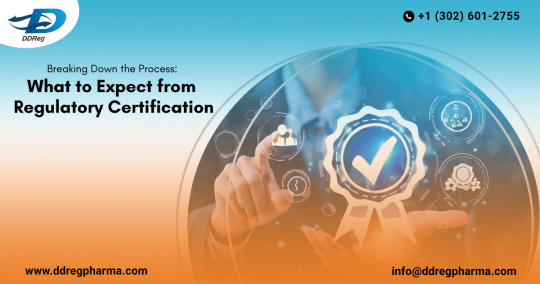#RegulatoryCertification
Text
Breaking Down the Process: What to Expect from Regulatory Certification

Navigating the maze of regulatory certification can be daunting for businesses, especially those venturing into new markets or industries. Regulatory certification is crucial as it ensures that products or services meet specific standards and comply with legal requirements, safeguarding consumers and ensuring fair competition. This blog will break down the process, highlighting what businesses can expect and how to streamline their path to compliance.
Understanding Regulatory Certification
Regulatory certification is a formal process through which a product, service, or company is evaluated to ensure it complies with the regulations and standards set by a governing body. These regulations can vary significantly depending on the industry, region, and specific product or service in question. Common sectors requiring stringent regulatory certification include pharmaceuticals, medical devices, automotive, electronics, and food and beverages.
Initial Assessment
The journey towards regulatory certification begins with an initial assessment. This stage involves thoroughly understanding the specific regulations and standards applicable to your product or service. It is crucial to identify the governing bodies relevant to your industry, such as the FDA (Food and Drug Administration) for medical devices in the United States or the CE (Conformité Européene) marking for products sold within the European Economic Area.
Key Steps in Initial Assessment:
Research Regulatory Requirements: Gather information on the regulatory affairs services requirements and standards relevant to your product or service. This may involve reviewing guidelines, standards documents, and industry publications.
Consult with Experts: Engage with regulatory consultants or industry experts to gain insights and clarify any ambiguities in the regulatory requirements.
Identify Compliance Gaps: Conduct a gap analysis to identify areas where your product or service may not meet regulatory standards. This will help in creating a roadmap for necessary modifications or improvements.
Documentation and Submission
Once the initial assessment is complete, the next step is to compile the required documentation. Proper documentation is critical as it provides evidence that your product or service meets the necessary standards and regulations. The documentation requirements can vary widely but generally include technical specifications, safety data, test reports, and quality management system documents.
Key Steps in Documentation:
Prepare Technical Files: Create detailed technical files that include product design, manufacturing processes, risk assessments, and compliance with relevant standards.
Conduct Testing: Perform necessary testing to demonstrate compliance with safety and performance standards. This may involve in-house testing or using accredited external laboratories.
Compile Quality Management System (QMS) Documents: If required, document your quality management system, including procedures, policies, and records that demonstrate your commitment to maintaining quality standards.
Submission and Review
With all documentation in place, the next step is to submit your application to the relevant regulatory body. This stage involves a thorough review process where the regulatory authority examines your documentation, conducts audits if necessary, and may request additional information or clarification.
Key Steps in Submission and Review:
Submit Application: Submit your complete application, including all required documentation and fees, to the relevant regulatory body.
Respond to Queries: Be prepared to respond promptly to any queries or requests for additional information from the regulatory authority.
Undergo Audits: In some cases, the regulatory body may conduct on-site audits or inspections to verify compliance with standards and regulations.
Certification and Maintenance
Upon successful review and approval, you will receive your regulatory certification. However, the process doesn’t end here. Maintaining compliance is an ongoing commitment, requiring regular audits, updates to documentation, and continuous monitoring of regulatory changes.
Key Steps in Certification and Maintenance:
Receive Certification: Obtain your regulatory certification, which may include certificates, marks, or official approval letters.
Conduct Regular Audits: Schedule and conduct regular internal and external audits to ensure ongoing compliance with regulatory standards.
Stay Informed: Keep abreast of changes in regulations and standards, and update your processes and documentation accordingly.
Conclusion
Regulatory certification is a critical step for businesses to ensure their products or services meet industry standards and legal requirements. By understanding the process, conducting thorough assessments, preparing detailed documentation, and maintaining ongoing compliance, businesses can navigate the regulatory landscape with confidence. This commitment not only ensures market access but also builds trust and credibility with consumers and stakeholders.
0 notes